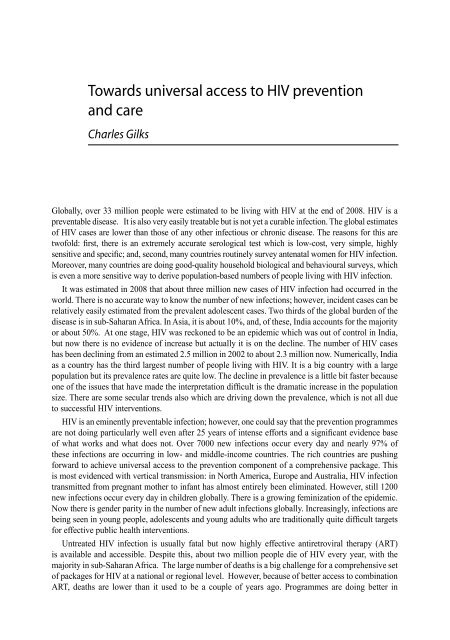South-East Asia Regional Conference on Epidemiology
South-East Asia Regional Conference on Epidemiology
South-East Asia Regional Conference on Epidemiology
Create successful ePaper yourself
Turn your PDF publications into a flip-book with our unique Google optimized e-Paper software.
Towards universal access to HIV preventi<strong>on</strong><br />
and care<br />
Charles Gilks<br />
Globally, over 33 milli<strong>on</strong> people were estimated to be living with HIV at the end of 2008. HIV is a<br />
preventable disease. It is also very easily treatable but is not yet a curable infecti<strong>on</strong>. The global estimates<br />
of HIV cases are lower than those of any other infectious or chr<strong>on</strong>ic disease. The reas<strong>on</strong>s for this are<br />
twofold: first, there is an extremely accurate serological test which is low-cost, very simple, highly<br />
sensitive and specific; and, sec<strong>on</strong>d, many countries routinely survey antenatal women for HIV infecti<strong>on</strong>.<br />
Moreover, many countries are doing good-quality household biological and behavioural surveys, which<br />
is even a more sensitive way to derive populati<strong>on</strong>-based numbers of people living with HIV infecti<strong>on</strong>.<br />
It was estimated in 2008 that about three milli<strong>on</strong> new cases of HIV infecti<strong>on</strong> had occurred in the<br />
world. There is no accurate way to know the number of new infecti<strong>on</strong>s; however, incident cases can be<br />
relatively easily estimated from the prevalent adolescent cases. Two thirds of the global burden of the<br />
disease is in sub-Saharan Africa. In <str<strong>on</strong>g>Asia</str<strong>on</strong>g>, it is about 10%, and, of these, India accounts for the majority<br />
or about 50%. At <strong>on</strong>e stage, HIV was reck<strong>on</strong>ed to be an epidemic which was out of c<strong>on</strong>trol in India,<br />
but now there is no evidence of increase but actually it is <strong>on</strong> the decline. The number of HIV cases<br />
has been declining from an estimated 2.5 milli<strong>on</strong> in 2002 to about 2.3 milli<strong>on</strong> now. Numerically, India<br />
as a country has the third largest number of people living with HIV. It is a big country with a large<br />
populati<strong>on</strong> but its prevalence rates are quite low. The decline in prevalence is a little bit faster because<br />
<strong>on</strong>e of the issues that have made the interpretati<strong>on</strong> difficult is the dramatic increase in the populati<strong>on</strong><br />
size. There are some secular trends also which are driving down the prevalence, which is not all due<br />
to successful HIV interventi<strong>on</strong>s.<br />
HIV is an eminently preventable infecti<strong>on</strong>; however, <strong>on</strong>e could say that the preventi<strong>on</strong> programmes<br />
are not doing particularly well even after 25 years of intense efforts and a significant evidence base<br />
of what works and what does not. Over 7000 new infecti<strong>on</strong>s occur every day and nearly 97% of<br />
these infecti<strong>on</strong>s are occurring in low- and middle-income countries. The rich countries are pushing<br />
forward to achieve universal access to the preventi<strong>on</strong> comp<strong>on</strong>ent of a comprehensive package. This<br />
is most evidenced with vertical transmissi<strong>on</strong>: in North America, Europe and Australia, HIV infecti<strong>on</strong><br />
transmitted from pregnant mother to infant has almost entirely been eliminated. However, still 1200<br />
new infecti<strong>on</strong>s occur every day in children globally. There is a growing feminizati<strong>on</strong> of the epidemic.<br />
Now there is gender parity in the number of new adult infecti<strong>on</strong>s globally. Increasingly, infecti<strong>on</strong>s are<br />
being seen in young people, adolescents and young adults who are traditi<strong>on</strong>ally quite difficult targets<br />
for effective public health interventi<strong>on</strong>s.<br />
Untreated HIV infecti<strong>on</strong> is usually fatal but now highly effective antiretroviral therapy (ART)<br />
is available and accessible. Despite this, about two milli<strong>on</strong> people die of HIV every year, with the<br />
majority in sub-Saharan Africa. The large number of deaths is a big challenge for a comprehensive set<br />
of packages for HIV at a nati<strong>on</strong>al or regi<strong>on</strong>al level. However, because of better access to combinati<strong>on</strong><br />
ART, deaths are lower than it used to be a couple of years ago. Programmes are doing better in









